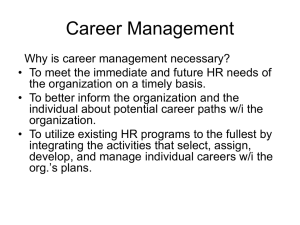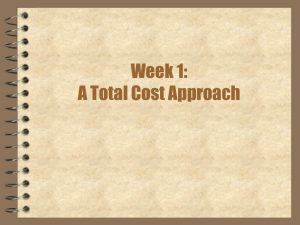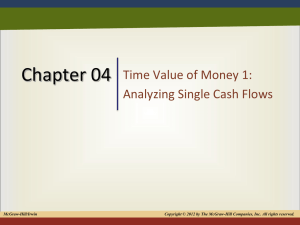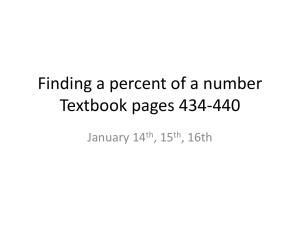slides
advertisement
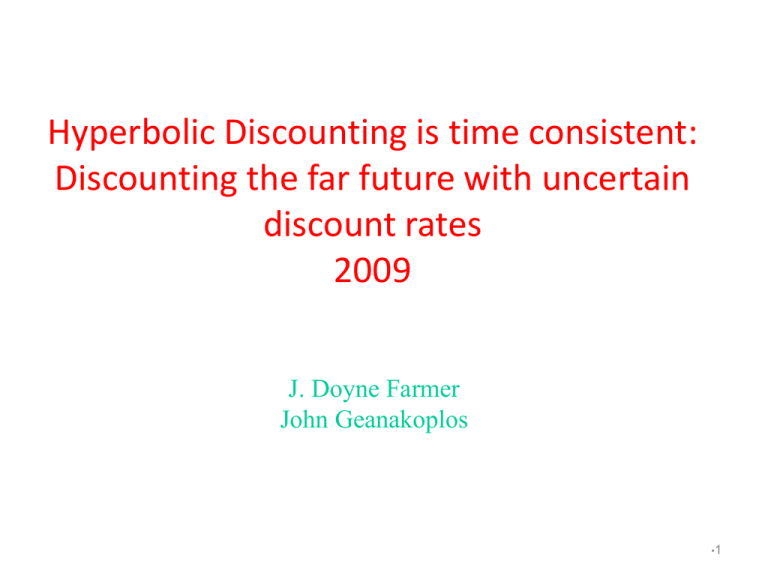
Hyperbolic Discounting is time consistent:
Discounting the far future with uncertain
discount rates
2009
J. Doyne Farmer
John Geanakoplos
•1
The Environment
• How much should we do today to make the
environment better in 200 years or 500 years?
• How to trade off the present vs the future?
• Economists all seem to agree we should
exponentially discount the future at some
rate.
• Conservatives say 3% per year. Nordhaus.
• Liberals say 0.5% per year (Stern report).
•2
Discounting the future
• How does one compare something today with something
tomorrow?
• How do we value something for current generations in
comparison with future generations?
• Ramsay (1928): For consumption stream (x0,x1,x2,…)
• U(x) = u(x0) + D(1)u(x1) + D(2)u(x2) + …
• Ramsay argued for D(t) = 1
– To discount later generations in favor of earlier ones is “ethically
indefensible and arises merely from the weakness of the
imagination”
– … it is “a polite expression for rapacity and the conquest of reason by
passion” (Harrod, 1948)
– Reinterpret as consumption stream by same agent; get discounting.
•3
Reasons for Discounting
• Impatience: Fisher, Shakespeare
• Probability of Death: Rae
• Failure of imagination: Bohm-Bawerk
•4
Exponential discounting
• Standard approach in neoclassical economics is
exponential discounting (Samuelson).
D er
•
= 1/(1+r0)τ
• Analogous to present value with constant bank
interest rate
r.
e r 1
r
e
1
– At
time
you
would
have
– Discount for time is therefore
money now
r
e
money later
•5
Value of far future under
exponential discounting?
• Under exponential discounting with realistic
interest rates, the far future is not worth much
• E.g., with interest rate of 6%, 100 years out the
discount factor is 0.0025.
• This is used by some economists to argue that we
should put very little effort into coping with
phenomena such as global warming that create
problems in the far future.
•6
Copenhagen Consensus
(eight leading economists, four Nobel prize winners)
Qui ckTime™ and a
TIFF ( Uncompressed) decompressor
are needed to see this pi cture.
Bjorn Lomborg
Concerning global warming:
“If we use a large discount
rate, they will be judged to be
small effects” (Robert
Mendolson, criticizing an
analysis by Cline using 1.5%
discounting)
•7
Discounting of far future is very
sensitive to the interest rate
100 years into the future:
interest rate
10%
-5
discount factor 5 x 10
5%
1%
-3
7 x 10 0.37
So how to pick the discount rate?
•8
Market interest rates
• We can see what the market interest rates are.
• At the moment they are the lowest ever.
• 1% per year for under a year, rising to 3% per
year or so in 10 years. Seems to stay thereafter.
• But don’t have interest rates for beyond 30
years in heavily traded markets. Most bonds of
30 year maturity or less.
• Some English consols. Also old railroad bonds.
Trade for very low interest rates. Curiosity?
• Must make up rates beyond 30 years.
•9
Hyperbolic discounting
• Early D(t) goes down exponentially, but for
large t, D(t) goes down slowly.
• D(t+1)/D(t) → 1.
• The most commonly used functional form
with this property is
D(t) (1 t)
•α
= 1, β = ½
•D(t)
≈ 1/√t
•10
Animals and Real People Are
Hyperbolic Discounters
Strotz
Laibson
Loewenstein
Ainslie
Ainslie-Hernnstein
•11
E.g. Thaler experiment
• How much money would you need in the
future in lieu of $15 today?
time
amount discount
int erest rate
15
month $20
D(1) =
0.751
345%
20
15
year
$50
D(12)
0.9012
120%
50
15
10 years $100
D(120)
0.98120 19%
100
•
Fits hyperbolic model with β = 1/2
•12
Rabin Story
• Girl asked to clean her room today vs
tomorrow. Much rather do it tomorrow.
• When asked to clean her room in 365 days or
366 days, it doesn’t matter to her. The ratio of
what she would pay today to get out of doing
it in 365 days to getting out of it in 366 days is
barely bigger than 1.
•13
Iroquois constitution
• Gayanashagowa -- Great Law of Peace -constitution of the Haudenosaunee
• In every deliberation we must consider the
impact on the 7th generation … even if it
requires having skin as thick as the bark of a
pine.
•14
Even animals use hyperbolic
discounting
QuickTime™ and a
T IFF (Uncompressed) decompressor
are needed to see t his picture.
Widely viewed as “irrational”, or at least “behavioral”.
•15
Is hyperbolic discounting time
consistent?
• Clearly agents could not be Samuelson
discounters.
• If D(t)/D(t+1) goes down, is that time
consistent behavior?
•16
Hyperbolic discounting seems
irrational
• Only way for D(t+1)/D(t) → 1 seems to be if
people think in the future they will become
more patient.
• Or in future will become less likely to die in
one year.
• Or will develop better imagination about the
future as they get older.
• All implausible.
•17
Hyperbolic discounting is irrational
• If world is certain
• People do not think they will grow more
patient, or less likely to die, etc
•18
Rabin Story
• Girl asked to clean her room today vs tomorrow. Much
rather do it tomorrow.
• When asked today to clean her room in 365 days or 366
days, it doesn’t matter to her.
• But if asked today whether she thinks in 365 days if she is
asked to clean her room it will matter whether it is then
or the next day, she will say it likely will matter
• Sounds time inconsistent, and Rabin and most others
agree. They exult in the irrationality.
• But public policy should be rational!
•19
Solution: One Period Discount is
Random!
• Future interest rates are not known today for
sure.
• People don’t know how urgent their one
period impatience will be.
• Death probabilities vary.
• An entire industry on Wall Street built to
analyze values when future interest rates
unknown.
• How does this help if future interest rates on
average are at least as high as today?
•20
Geometric Random Walk Interest
Rate Model
•
•
•
•
•
Called Black-Derman-Toy model
(Ho-Lee model same but with random walk)
Workhorse of finance.
Analyzed to death for t < 30 years
But not for large t
•21
.5
.5
.5
v = volatility
.5
.5
.5
•22
•23
D(t) = how much would you pay
today for $1 for sure at time t
• Clearly discount factor D(t) must depend on
what market expects future one period
discounts to be; otherwise there would be
arbitrage opportunities.
• Two wrong answers!
• D(τ)=e-E₀[r₀]e-E₀[r₁]...e-E₀[rτ-1] < e-r₀τ
• D(τ)=E₀[e-r₀]E₀[e-r₁]...E₀[e-r(τ-1)] ≈ K(1/2)τ
• Both wrong answers lead to more
discounting!
•24
D(t) = how much would you pay
today for $1 for sure at time t
• Suppose common knowledge that at any time
t, can always make bet at even odds that
interest rate will go up or down.
• Then correct answer by no-arbitrage must be
average product of one period discounts over
all paths to period t.
• D(τ)=E₀[e-r₀e-r₁...e-r(τ-1)]
•25
.5
.5
.5
v = volatility
.5
.5
.5
•26
Theorem
• In geometric random walk, the discount factor
D(τ) goes down exponentially at first, at rate
faster than r0, but converges to
• D(τ) = Kτ-1/2 as τ → ∞. So hyperbolic
discounting is rational.
• D(t+1)/D(t) ≈ √(t+1)/√t
• Length of time before entering hyperbolic
region is shorter if vol is higher.
• Here K is a constant, or maybe a slowly
varying function like 1/log. Logt/ √t is tiny.
•27
r0=4%, v = 50%
Farmer and Geanakoplos
•28
Comparison of discount factors x 100
(15% annual volatility, 4% initial rate)
year rnd. wlk. constant
20
46.2
45.6
60
12.5
9.5
100
5.1
2.0
-7
500
0.80
2 x 10
-16
1000
0.50
4 x 10
•29
Fits Thaler data
•30
Why is this true?
• Think of one period discount as coming from
one year death probability.
• Hazard probability follows random walk.
• Conditional on living for 100 years, likely were
following path with very low one year death
rates. If one year death probs got bad, you
would already be dead.
• Hence conditional probability of living one
more year after making it to 100 is very high.
• Familiar idea in economics.
•31
Where does 1/√t come from?
2n
≈ 22nK/√n
n
t = 2n
Proportion of 22n possibilities is about K/√n ≈ K/√t
•32
Idea of Proof
• Consider the case where volatility v = ∞.
• Then have three kinds of paths:
• Good paths: Those in which from time 1
onward remain strictly below median.
• Mediocre paths: Those in which from time 1
onward hit median but remain below median.
• Bad paths: Those in which at some date go
above median. These contribute zero to value
•33
Good Path: starts down and never hits r0
r0
0
-1
-3
•34
Another Good Path: same number of ups as downs
r0
0
•35
Good paths
• Might as well start all paths at -1 at time 1, and
go for T-1 periods = 2n.
• End up at -1 or -3 or -5 etc.
• So can count total number of good paths by
adding number that end at -1 plus number that
end at -3 plus number that end at -5 etc.
• Total paths that start at -1 and end at -1 have
right proportion 1/√T. But need to subtract out
non-good paths that start and end at -1, and add
good paths that end at -3 plus -5 etc.
•36
Bad Path
r0
•37
Reflection Principle
r0
•38
Reflection Principle for paths end -1
• Number of non-good paths that start at -1 and hit
or cross 0 and end at -1 is equal to all paths that
start at +1 and end at -1.
• But that is equal to number of all paths that start
at -1 and end at -3.
• Hence number of good paths that start at -1 and
end at -1 is equal to the number of all paths that
start at -1 and end at -1 minus the number of all
paths that start at -1 and end at -3.
•39
Reflection Principle for paths end -3
• Number of non-good paths that start at -1 and hit
or cross 0 and end at -3 is equal to all paths that
start at +1 and end at -3.
• But that is equal to number of all paths that start
at -1 and end at -5.
• Hence number of good paths that start at -1 and
end at -3 is equal to the number of all paths that
start at -1 and end at -3 minus the number of all
paths that start at -1 and end at -5.
•40
Number of good paths equals
• All paths that end at -1 minus all paths that
end at -3
• Plus
• All paths that end at -3 minus all paths that
end at -5
• Plus etc
• Equals all paths that end at -1.
•41
End of Proof for v = ∞
• So all good paths has right proportion of all
paths.
• Must count total number of mediocre paths
that hit 0 but do not cross zero.
• Same technique can be used to show that is
exactly equal to number of paths that never
hit 0. These paths all get discounted.
• In fact can compute how many paths get
discounted k times, for each k.
•42
Proof for v < ∞
• Key idea is that when interest rate goes down
exponentially, discount rate goes up doubly
exponentially. So after logT periods of going
down, discount factor is essentially 1.
• D = 1/(1+r0(e-v)(1/v)logT)= 1/(1+r0/T)
• Even if one period discount factor is D from
then on until T, get virtually no discounting
• DT = (1/(1+r0/T))T = e-r0
•43
Strip: Everything Below is Good Path
Period 0
Period T
r0
(1/v)logT
Good path starting here
•44
Proof for v < ∞
• Let N = logT + 1. Note N/√T ≈ 0.
• So probability that path starting at 0 goes first to -1 is
½.
• For T large probability that path exits strip is ≈ 1.
• Then probability the path exits at bottom of strip
before exiting at top is 1/N by gambler’s ruin theorem.
• Once out at bottom fraction of good paths that never
enter strip again is at least 1/√T.
• So get D(t) ≥ 1/2N√T times discounting while in strip.
•45
Discounting While in Strip
• Actually spend pretty long in strip before
exiting at bottom. If visited every line equally
while in strip before exiting at bottom, then
too much discounting.
• But can show spend most of time while in
strip before exiting at bottom near middle of
strip, where discount factor already near 1.
•46
Discounting While in Strip
• Let Π(i) = i/N = prob of exiting at N starting at i.
• Let E(i,k) = expected number of times you hit k
starting at i before exiting, with i≤ k ≤ N.
• Clearly E(i,N) = Π(i).
• Π(i) = E(i,k)(1/2)(1/(N-k)) if i < k < N
• E(i,k) = 2 Π(i)(N-k)
• Let W(i,k) = expected hits of k that also exit at N.
• W(1,k) = (k/N)E(1,k) = 2k(N-k)/N2
• W(1,k)N = 2k(N-k)/N = expected number of hits
of k starting at 1 conditional on exiting at N
•47
Generalizatios
• Asymptotic Behavior of Stochastic Discount
Rate
• Geanakoplos-Sudderth-Zeitouni
• Instead of binary, let v be any bounded
random variable with zero mean and positive
variance. Then
• 1/√t-o(1) < D(t) < 1/√t+o(1)
•48
End
•49
Utility today and in the future over
certain prizes
•50
•51
Conclusion from certainty and time
consistency
Discount factor Ds(τ) must be the product
of one-period discounts Ds+i(1).
•52
Certainty, time consistency and
strict stationarity
• Exponential discounting is time consistent and strictly
stationary, I.e. rs+τ = r is constant independent of t.
• Samuelson exponential discounting is the only time consistent,
strictly stationary discounting function under certainty.
•53
Give up strict stationarity
• But then must have Ds(1) declining with time s.
• This is implausible because death hazard is increasing not
decreasing with age. People do not get more patient with age;
more likely they undertake fewer long term projects. That is point
of Rabin story.
• So it would seem that hyperbolic discounting is incompatible with
time consistency, i.e. incompatible with rationality.
• But it is compatible with time consistency if we give up certainty as
well.
•54
The discount is not constant
•
•
•
•
Urgencies vary
Hazards vary
Interest rates vary
The future is uncertain, and uncertainties are typically correlated in
time.
• Under these circumstances, on average hyperbolic discounting is
time consistent -- each step uses exponential discounting, but at
varying rates. Result is not exponential!
•55
Key uncertainty
• One period discount Ds+τ(1) is not known at s
• So utility of x depends not just on time s that one considers x, but
also the psychological one-period discount rate r at that time,
Us,r(x).
• Can rehabilitate weak stationarity by requiring that if x is constant,
then utility should depend on r but not on s.
• Can also assume that given r, r one period later is likely to be at
least as high, so that on average people get more impatient
•56
time consistency with certainty
to time consistency with
uncertainty
•57
Discounting certain payoffs with
uncertain discount rates
• As long as the payoffs are certain, even if
they depend on time, it makes sense to
compare consumption today vs
consumption at a fixed time in the future.
Let us call the resulting certainty discount
factors Ds(τ).
• Time consistency requires
• Ds(τ) = average[exp(Σi=0τ-1-rs+i)
•58
Weitzman example
• Suppose interest rate has probability ½ of being high R per period
forever after, and probability ½ of being low r per period forever
after.
• Then Ds(τ) converges to 1/2e-rτ as τ → ∞.
• This is known as convexity if finance. Comes from autocorrelation
of interest rates.
• Weitzman argued that for long horizons like environment, should
think of very low interest rates.
•59
Discount factors in geometric random
walk
= 2τ-1.
•
Where N(τ)
•
When payoffs xs are certain functions of time
•60
Theoretical explanation
• Consider high volatility limit
• Discount rate tree has a “cliff”: 0 or 1
• Discount rate is fraction of paths that do not
cross the cliff.
• Random walk with barrier crossing
• Scales as
1/ 2
t
• Implies non-integrability!
•61
Who is the better economist?
QuickTime™ and a
T IFF (Uncompressed) decompressor
are needed to see t his picture.
pigeon
Qui ckTime™ and a
TIFF ( Uncompressed) decompressor
are needed to see this pi cture.
12 economists in Copenhagen
consensus
•62
r0={.5, 1,100}%, v = 100%
•63
